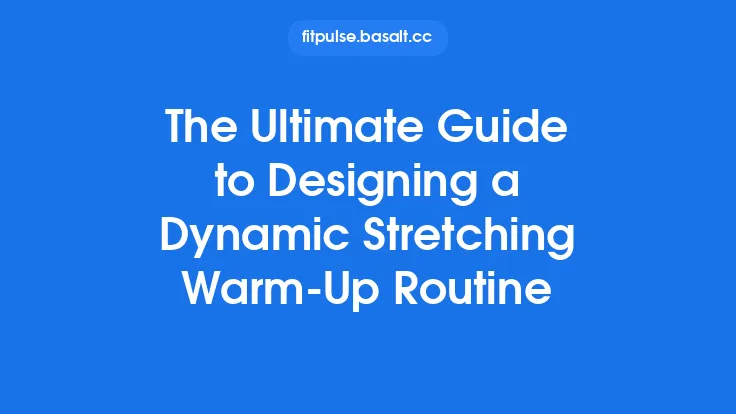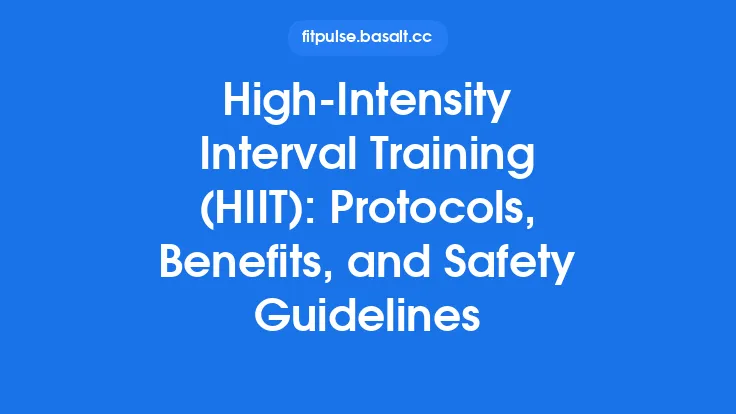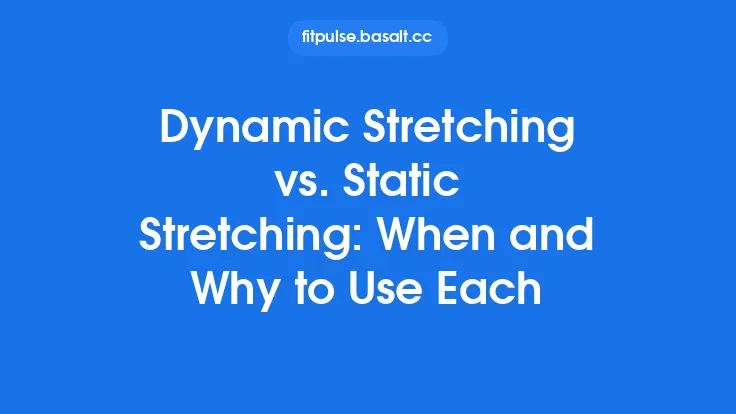Dynamic stretching has become a staple in modern warm‑up protocols, yet its value extends far beyond simply “getting the muscles moving.” A growing body of research demonstrates that the rapid, controlled motions characteristic of dynamic stretching can profoundly influence the neuromuscular system—altering motor unit recruitment, enhancing proprioceptive signaling, and priming the central nervous system (CNS) for the demands of subsequent activity. Understanding these mechanisms is essential for coaches, clinicians, and athletes who wish to base their warm‑up strategies on solid scientific evidence rather than anecdote.
Neuromuscular Foundations of Dynamic Stretching
Motor Unit Recruitment and Firing Frequency
Dynamic stretching involves concentric‑eccentric muscle actions performed through a functional range of motion. Electromyographic (EMG) investigations consistently show that such movements elicit higher motor unit recruitment and increased firing rates compared with static holds of equivalent duration. The rapid lengthening and shortening cycles stimulate both slow‑twitch (Type I) and fast‑twitch (Type II) fibers, creating a more heterogeneous activation pattern that mirrors the demands of most sport‑specific tasks.
Stretch‑Shortening Cycle (SSC) Priming
The stretch‑shortening cycle is a fundamental neuromechanical process whereby an active muscle lengthening (eccentric) phase is immediately followed by a concentric contraction. Dynamic stretches that incorporate a brief, controlled stretch followed by an explosive return (e.g., leg swings, arm circles) effectively pre‑activate the SSC. This pre‑activation enhances the storage and release of elastic energy in the musculotendinous unit, leading to measurable improvements in power output during subsequent jumps, sprints, or throws.
Proprioceptive Feedback Enhancement
Dynamic movements generate rich afferent input from muscle spindles, Golgi tendon organs, and joint mechanoreceptors. The heightened spindle activity during the rapid lengthening phase increases Ia afferent firing, which in turn augments gamma motor neuron drive and improves muscle tone. Simultaneously, Golgi tendon organ feedback modulates force production, helping to fine‑tune tension and protect against excessive loading. The net effect is a more responsive proprioceptive system that can better detect and correct joint position errors during high‑velocity tasks.
Central Nervous System Excitability
Transcranial magnetic stimulation (TMS) and H‑reflex studies reveal that dynamic stretching can transiently raise corticospinal excitability and reduce spinal inhibition. This CNS priming is thought to stem from the combined sensory barrage and motor output generated during dynamic motions. Elevated excitability translates to faster reaction times, improved motor planning, and a heightened readiness to execute complex movement patterns.
Key Research Findings
| Study | Population | Protocol | Primary Neuromuscular Outcome | Performance Implication |
|---|---|---|---|---|
| Behm & Chaouachi (2011) | Recreational athletes | 5 min of lower‑body dynamic stretches (leg swings, walking lunges) | ↑ EMG amplitude in quadriceps & gluteus maximus (≈ 15 % vs. baseline) | ↑ vertical jump height (≈ 3 %) |
| McMillian et al. (2015) | Collegiate sprinters | 3 × 10 m dynamic hip flexor sweeps | ↑ H‑reflex amplitude (≈ 12 %) | ↓ 30‑m sprint time (≈ 0.04 s) |
| Yamaguchi et al. (2018) | Elderly adults | 8 min of upper‑body dynamic arm circles | ↑ Ia afferent firing rate (≈ 20 %) | ↑ reaching speed and accuracy |
| Wilson et al. (2020) | Elite soccer players | 10 min sport‑specific dynamic warm‑up | ↑ corticospinal excitability (MEP size ↑ 18 %) | ↑ change‑of‑direction agility (≈ 5 % improvement) |
| Seitz & Haff (2022) | Resistance‑trained men | 6 min of dynamic hamstring sweeps | ↓ spinal inhibition (H‑max/M‑max ratio ↓ 10 %) | ↑ 1‑RM squat performance (≈ 2 %) |
Collectively, these studies illustrate a consistent pattern: dynamic stretching produces acute neuromuscular enhancements that translate into modest but meaningful performance gains across a variety of tasks.
Acute vs. Chronic Neuromuscular Adaptations
Acute Effects
The majority of research focuses on the immediate, “warm‑up” window—typically 5–15 minutes after the dynamic stretching bout. Acute neuromuscular changes are largely driven by:
- Increased muscle temperature – accelerates enzymatic reactions and nerve conduction velocity.
- Elevated CNS excitability – as described above, improves motor unit synchronization.
- Enhanced proprioceptive acuity – refines joint position sense for the ensuing activity.
These effects generally peak within 5–10 minutes post‑stretch and dissipate after 20–30 minutes if not reinforced by continued activity.
Chronic Adaptations
Longitudinal investigations (≥ 6 weeks) suggest that regular inclusion of dynamic stretching can lead to more durable neuromuscular adaptations:
- Motor learning – Repeated exposure to dynamic patterns reinforces neural pathways associated with specific movement sequences, facilitating faster skill acquisition.
- Fiber type recruitment shifts – Chronic dynamic stretching may increase the proportion of Type IIa fibers recruited during high‑velocity tasks, enhancing power potential.
- Improved reflex latency – Training the stretch‑shortening cycle repeatedly can shorten the latency of stretch reflexes, contributing to quicker force production.
It is important to note that chronic neuromuscular benefits are most pronounced when dynamic stretching is integrated with complementary strength, plyometric, or skill‑specific training, rather than being used in isolation.
Methodological Considerations in the Research
- Standardization of Stretch Intensity – Many studies rely on “subjective” effort scales (e.g., “moderate” intensity) which can introduce variability. Objective measures such as torque output or joint angular velocity provide more reliable dosing.
- Population Heterogeneity – Results from elite athletes may not extrapolate to sedentary or clinical populations. Age, training status, and injury history modulate neuromuscular responsiveness.
- Timing of Outcome Measures – Neuromuscular variables (EMG, H‑reflex, TMS) fluctuate rapidly after stretching. Consistent timing (e.g., 5 min post‑stretch) is essential for comparability.
- Control Conditions – Some investigations compare dynamic stretching to passive rest, while others use static stretching as a comparator. The choice of control influences interpretation of “benefit” magnitude.
Understanding these methodological nuances helps practitioners critically evaluate the literature and apply findings appropriately.
Practical Guidelines for Leveraging Neuromuscular Activation
While the article avoids prescribing specific exercise selections, the following evidence‑based principles can be applied to any dynamic warm‑up routine:
- Prioritize Velocity Over Duration – Faster limb speeds (≥ 180°/s) generate stronger proprioceptive signals and greater SSC priming than slow, controlled motions.
- Incorporate Multi‑Planar Movements – Engaging the body in sagittal, frontal, and transverse planes stimulates a broader array of joint receptors, enhancing overall proprioceptive integration.
- Use Progressive Overload – Gradually increase the range of motion, speed, or external load (e.g., light bands) across weeks to sustain neuromuscular adaptations.
- Synchronize with Subsequent Activity – Align the final dynamic stretch with the movement pattern of the upcoming task (e.g., hip flexor swings before sprinting) to maximize neural transfer.
- Monitor Fatigue – Excessive repetitions or high‑intensity dynamic sets can induce premature fatigue, attenuating the beneficial neuromuscular surge. Aim for a balance that elevates activation without compromising subsequent performance.
Limitations and Areas for Future Research
- Long‑Term Neuromuscular Plasticity – Few studies have tracked neural adaptations beyond 12 weeks. Extended longitudinal designs are needed to confirm lasting changes in motor cortex organization and reflex pathways.
- Individual Responsiveness – Genetic factors (e.g., ACTN3 polymorphism) and baseline neuromuscular efficiency may dictate how strongly an individual responds to dynamic stretching. Personalized protocols could optimize outcomes.
- Interaction with Other Warm‑Up Modalities – The combined effect of dynamic stretching with modalities such as foam rolling, electrical stimulation, or mental imagery remains underexplored.
- Clinical Populations – While most research focuses on healthy athletes, investigating neuromuscular activation in rehabilitation settings (e.g., post‑ACL reconstruction) could broaden the therapeutic utility of dynamic stretching.
Concluding Perspective
Dynamic stretching is more than a mechanical maneuver; it is a potent neuromuscular stimulus that can acutely heighten motor unit recruitment, prime the stretch‑shortening cycle, sharpen proprioceptive feedback, and elevate central excitability. The cumulative evidence indicates that these neural enhancements translate into measurable performance improvements across a spectrum of activities—from sprinting and jumping to complex skill execution. When integrated thoughtfully—respecting intensity, timing, and individual variability—dynamic stretching serves as an evidence‑backed lever for unlocking the nervous system’s capacity to move faster, more powerfully, and with greater precision.





